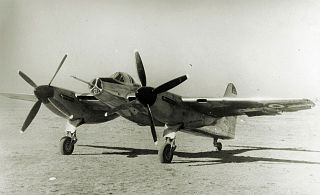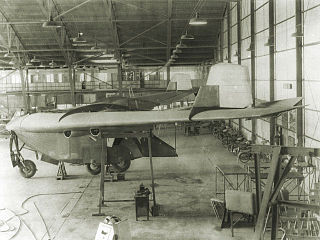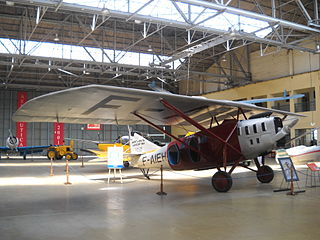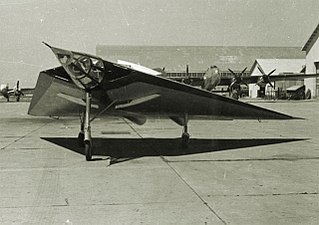| AeT.1 | |
|---|---|
 | |
| Role | Airliner |
| Manufacturer | FMA |
| First flight | 15 April 1933 |
| Primary user | Aero-Argentina |
| Number built | 3 |
The FMA AeT.1 was an airliner built in Argentina in the early 1930s.
| AeT.1 | |
|---|---|
 | |
| Role | Airliner |
| Manufacturer | FMA |
| First flight | 15 April 1933 |
| Primary user | Aero-Argentina |
| Number built | 3 |
The FMA AeT.1 was an airliner built in Argentina in the early 1930s.
The AeT.1 was a low-wing cantilever monoplane of conventional design, with fixed tailwheel undercarriage. Only three examples were built, christened General San Martín , Deán Funes , and Jorge Newbery . These aircraft provided Argentina's first scheduled airline services with Aero-Argentina, flying between Córdoba and Buenos Aires.
The Deán Funes was also used to make a long-distance flight to Ushuaia, bringing the first mail to that town after a flight of 6,500 km (4,000 mi).[ citation needed ] Air France director Colin Jeannel flew as a passenger on that flight.
General characteristics
Performance
Aircraft of comparable role, configuration, and era

The Avro 691 Lancastrian was a Canadian and British passenger and mail transport aircraft of the 1940s and 1950s developed from the Avro Lancaster heavy bomber. The Lancaster was named after Lancaster, Lancashire; a Lancastrian is an inhabitant of Lancashire.

The Aero Ae270 Spirit was a single-engine turboprop general utility aircraft that was developed by the Czech aircraft company Aero Vodochody. A prototype made its maiden flight in 2000, with European Aviation Safety Agency (EASA) Type Certification in 2005 and Federal Aviation Administration (FAA) type certification in 2006. No production followed.

The Northrop C-19 Alpha was a series of three aircraft purchased from Northrop by the US Army Air Corps in 1931. They were slightly modified versions of the civil Northrop Alpha Type 2.

The Tupolev ANT-14 Pravda was a Soviet aircraft, which served as the flagship of the Soviet propaganda squadron. It has been credited as Russia's first all-metal aircraft, with a corrosion-resistant-steel structure.

The I.Ae. 30 "Ñancú" was an Argentine twin piston engined fighter designed by the Instituto Aerotécnico in the late 1940s, similar to the de Havilland Hornet, but made of metal rather than wood. Only one prototype was completed; the project was abandoned in favour of the FMA I.Ae. 27 Pulqui I jet aircraft.

The Fokker F.25 Promotor, first flown in 1946, was a single-engined, twin-boomed, four-passenger monoplane with a pusher engine mounted at the rear of a central nacelle. It was of wooden construction and has fitted with a retractable nosewheel undercarriage. One feature of the design was that instead of a 2 + 2 seating, the pilot sat in front to the left, and all three passengers were on a bench seat to the rear of him. Alternatively, when being used as an air ambulance aircraft, it could carry a patient on a stretcher, which was loaded through a hatch in the aircraft's nose. The F.25 was evocative of the pre-war G.I design. The F.25 was based upon the design of the Difoga 421 aircraft, home-built and -designed during World War II by Frits Diepen, a Ford garage owner from Tilburg, the Netherlands. His intention was to create an easy to fly personal aircraft. Due to the war an aircraft engine was not available and instead it used a Ford V-8.

The Dewoitine D.332 was a 1930s French eight-passenger airliner built by Dewoitine.

The DINFIA IA 35 Huanquero was a 1950s Argentine twin-engined general-purpose monoplane aircraft built by the DINFIA.

The DINFIA IA 38 was a 1960s Argentine four-engine experimental tailless transport aircraft, designed under the direction of Reimar Horten and based on the German Horten Ho VIII project and built by the DINFIA.

The FMA AeMB.2 Bombi was a bomber aircraft developed in Argentina in the mid-1930s. It was a low-wing cantilever monoplane of conventional configuration. It was fitted with fixed tailwheel undercarriage, the main units of which were covered by long, "trouser"-style fairings. The initial AeMB.1 configuration was fitted with a dorsal machine gun turret, later removed from the AeMB.2 to improve stability. Fifteen production examples saw service with the Argentine Air Force between 1936 and 1945. Two were lost to air accidents.

The FMA AeC.1 was a light utility aircraft built in Argentina in 1931; it was the first aircraft of domestic design to be produced by Fabrica Militar de Aviones (FMA). It was a low-wing cantilever monoplane of conventional configuration with fixed tailskid undercarriage. As originally designed, the fully enclosed cabin had three seats, but this was later reduced to two. The passenger seat could be readily removed to make way for a stretcher to facilitate its use as an air ambulance.
The FMA AeC.3 was a light utility aircraft built in Argentina in 1934; a further development in the series of designs that had originated with the AeC.1 three years previously. Deliveries to Argentina's aeroclubs were made late in the year.

The Latécoère 25 was a French airliner built in 1925 for use on Latécoère's own airline and its subsidiaries. Essentially a refined version of the Latécoère 17 with an enlarged wingspan, it supplanted that type in production and then in service.

The Short S.11 Valetta was a 1930s British passenger monoplane designed and built by Short Brothers at Rochester.

The Avia 51 was a 1930s Czechoslovakian six-passenger commercial transport, designed by Robert Nebesář and built by Avia. The type was uneconomical in use and only three were built.

The FMA I.Ae. 37 was a prototype jet fighter developed in Argentina during the 1950s. It never flew and was cancelled in 1960.

The I.Ae.41 Urubú was a two-seat flying wing tailless glider, built in Argentina by the Fábrica Militar de Aviones (FMA) in the 1950s.

The Curtiss CA-1 was an American five-seat biplane amphibian designed by Frank Courtney and built by Curtiss-Wright at St Louis, Missouri.

The Tupolev Tu-116 is a turboprop-powered long-range airliner designed by the Tupolev design bureau and built in the USSR.

The 1929 Curtiss Model 53 Condor, also known as the Curtiss Model 53 Condor 18 or the Curtiss CO Condor, was a civil passenger version of the Model 52 Condor bomber. A twin-engined biplane, it carried 18 passengers.
| Wikimedia Commons has media related to FMA Ae. T.1 . |